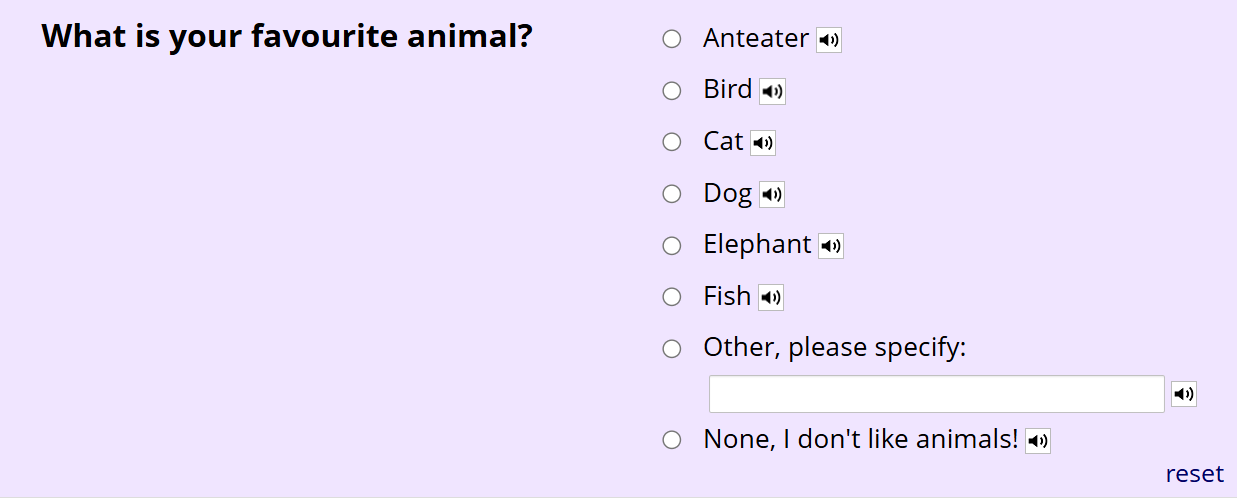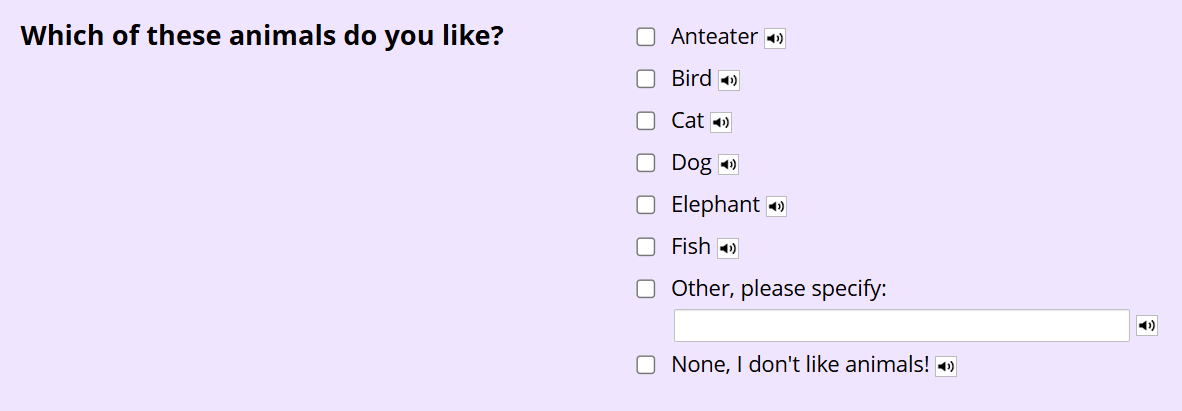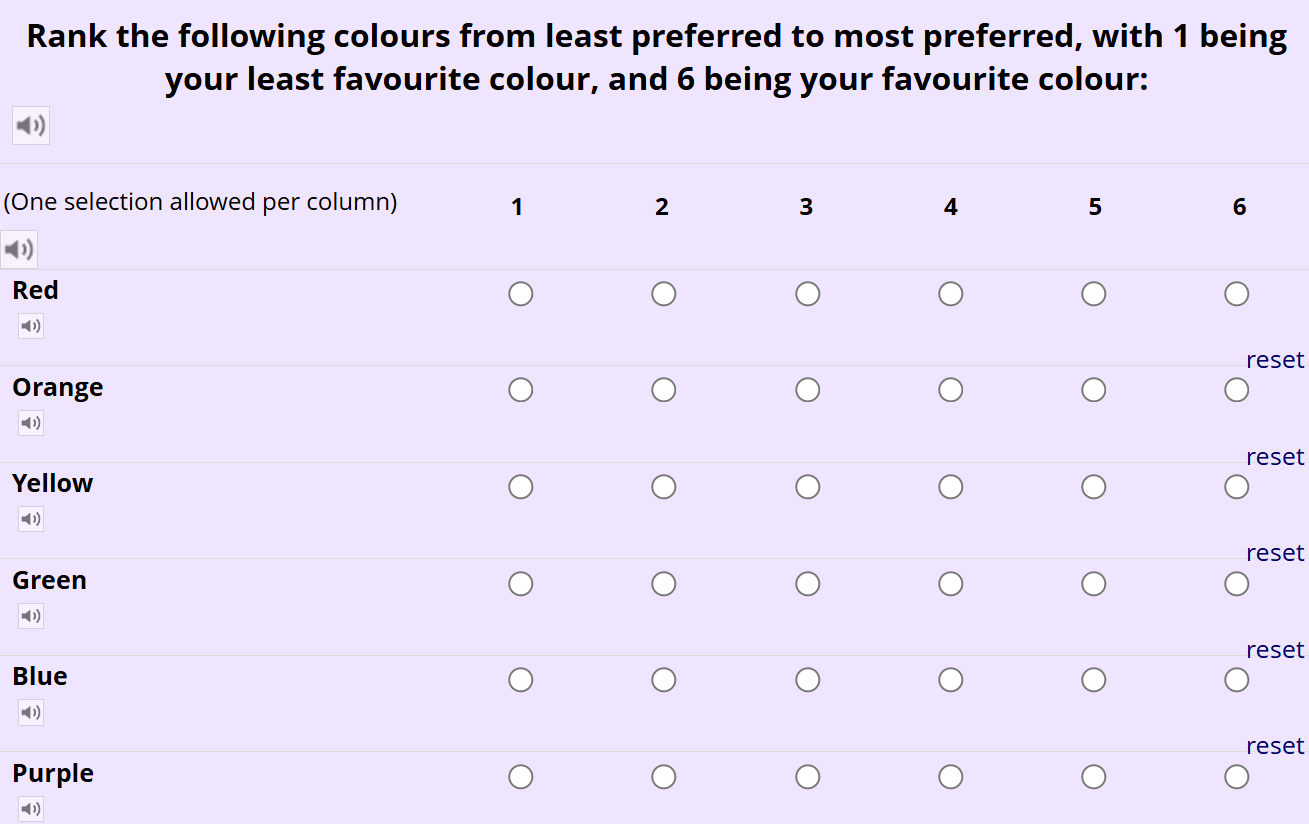Chapter 2: Developing a Research Study
Module 6: Accessible Survey Question Formats
So now that you’ve done the work to develop your general questions, what is the best way to format them? This is an often-overlooked aspect of survey design, especially in online spaces. Here we will present a variety of survey question formats, as they appear in the REDCap survey platform. However, these may also be applied to other survey platforms.
Learning Objectives
- Discover the different question formats which are often used in digital surveys, and their advantages and disadvantages.
Instead of a case study, click here to take the demo survey! Or, click here to download the survey as a PDF.
We have converted this chapter into an actual REDCap survey, which walks through an interactive look at these different question formats. We recommend using this survey to get the best experience of this module, however recognize that this is not everyone’s preferred information presentation style. Therefore, we have provided the same information in the standard format here as well.
Multiple Choice Questions
Multiple choice questions are tools which allow researchers to provide pre-selected answers for participants to choose from, streamlining the process of data collection and analysis.
These types of questions are extremely valuable in surveys- in fact, multiple choice questions are often the prototypical format that most people think of when they imagine survey research. Participants will be presented with a range of possible answers, which will ideally be reflective of the engaged population, and the specific phenomena being examined.
Multiple choice questions can take many forms, and can include questions which allow multiple responses as well as single responses, dependent on the concepts of interest.
Drop-Down Lists
A drop-down list, is a form of multiple choice question which differs from the stereotypical checkbox format by its structure. This format is specific to online surveys. A series of response options is available in a list format, which opens when clicked, and collapses once an option is chosen.
The following is a multiple choice question using a drop-down list:

These types of questions allow you to pick one choice from a series of options, in a drop-down list format. This is often considered a good format if there are a large number of options to pick from, such as your Province or Territory of residence.
However, some people consider these inaccessible, due to the extra steps involved to open the drop down, scroll through the options, and select one.
This format may also limit the types of responses you can allow, depending on the survey platform you use. For example, in REDCap, as pictured here, the drop-down list format does not allow an option to include an embedded text box with the “Other” option.
Please note that for most multiple choice questions, it is important to provide an “Other” option, with space to put in a customized answer. We will demonstrate this in the next type of mu tiple choice question, which uses single answer buttons.
Single Answer Buttons
The single answer multiple choice format differs from the drop-down list only in its format, where there is no scrolling list feature, and rather, a series of options checkboxes or “buttons”, from which participants may only select a single response.
Compared to the drop-down list, this format has been described as more accessible for people with visual disabilities, as it is more screen-reader accessible, and requires fewer steps to navigate responding. This format also makes it much simpler to include an “Other” option, with space for text.

Multiple Select Questions
The next type of question you will have had to complete at the beginning of this survey! This is a multiple choice format which allows participants to select more than one response, as they apply to each individual.
These are best used when asking about topics where allowing only one answer would limit the ability of a participant to have their perspective reflected accurately in the survey. Let’s revisit the same animal question used previously, but with a multiple select format.
You can see that the type of question is changed slightly, to broaden the number of possible selections:

Multiple Choice Matrices
The next type of multiple choice format is a matrix of choices, which can be used for a series of similar multiple-choice questions. It can exist as either a single-select of a response per field, or a multi-select of responses per field. These formats also serve to help create Likert scales.
I will provide a series of examples where you can see how this will work in both ways. The following is an example of a matrix with only a single answer for each category. It is also a good example of a Likert scale format. :

This next example demonstrates how you might use a multiple select matrix. Keep in mind that these can often be confusing unless clear instructions of how to use it are provided, making it less accessible for those who may not be fluent in English or have difficulties with language processing.
Consider each variable into separate questions, each with a “select all that apply” prompt. While taking up more space, this may be a clearer way of presenting the question, and minimize confusion, as you can see here:

Finally, here is an example of how a matrix might be useful as a ranking system. This is a great option in case you wish to have participants rank options in comparison to one another, rather than overall. It ensures that you cannot select the same rating more than once, and therefore encourages participants to look at variables in relation to one another. See the following:

Text-Based Questions
Text-based questions allow respondents to write their own answers to questions. This provides much higher specificity of answers, and can be useful for identifying information (which should be collected in very limited and only necessary amounts, as you may recall from Module 4)
Short Text

This is a short text question. These can be used for short and specific responses which will vary greatly per participant. Often, these smaller text boxes are used to collect identifying information, which cannot be prepared or anticipated in a multiple-choice format, such as phone numbers, names, or addresses and postal codes.
Paragraph Text

This is a paragraph text question. This basically performs the same function as the text box question, but on a larger scale, allowing more words for respondents. This is a great tool for gathering qualitative information such as lived experiences, additional details which they feel are relevant that have not been covered by survey questions, or key informant observations, without the limitations to time and to confidentiality which are experienced in qualitative interviews. This is also a good way to allow participants to provide feedback about the survey itself.
Miscellaneous and Other Question Types
The following section will detail other forms of survey questions, not categorized as multiple choice or as text responses.
Other File Uploads
This format of question asks participants to upload their own files as data to be analysed. This can serve as a great tool for qualitative research, and may allow people to provide photographs, drawings/art, audio files, their own field notes, videos, or others. This type of data can be extremely insightful, and even accessible, as it allows participants to share in whichever way they prefer. Take this example:

However, keep in mind that there is a level of digital literacy that is required for people to upload files on their own. This can create an added layer of complexity to navigate participation in the survey, and further the gap in who can and cannot participate. Therefore, providing easy and accessible support from the research team will be important to ensuring the accessibility of this format.
Visual Analog Scale
The next question format is a visual analog scale. It allows participants to visually represent, on a sliding scale, their responses to certain questions. While it seems to be a reliable, interactive tool, it may pose some difficulties for people with vision disabilities (it is a highly visual tool). Additionally, definitions along the sliding scale are unclear. You can see this in the following example.

Based on this question, how can we know how people would numerically or slide the scale to define their opinions? It is far too uncertain and can be a source of confusion. Instead, using a Likert scale as demonstrated in the “Multiple Choice Questions” section would be easier, to provide simple, clear options.
These are very common survey question formats. Remember that this is a brief overview of the formatting, and in order to get a better idea of the needs of your engaged population, co-design and piloting the survey in its intended digital format will be instrumental in assuring high levels of accessibility and inclusion.
"Observe the following"; a frequently used phrase by an early 2000's science education icon, Bill Nye the Science Guy (Bill! Bill! Bill! Bill!).


Feedback/Errata